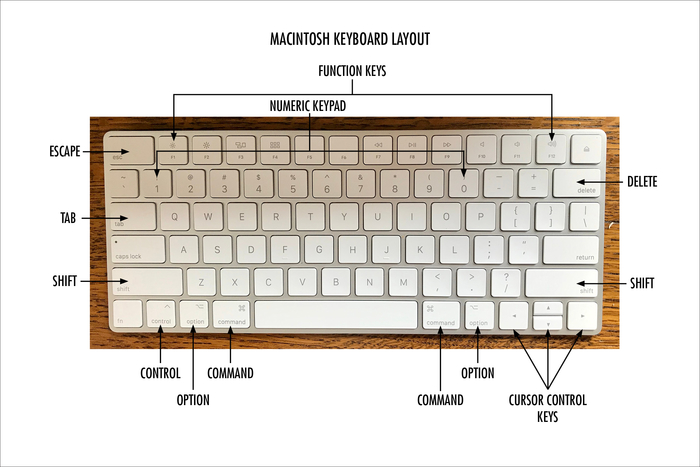
Hi, this is Kristin from the Media Lab. I hope you are all doing well. We miss seeing you in the lab and helping you with your creative projects. Until we meet again, Patrick and I will be posting some tech tips and tricks for you to make the most out of your time in quarantine, whether you are working at home or using your computer to create new projects. This week, I’m posting a blog about common Macintosh keyboard shortcuts to make your Macintosh computer experience more streamlined and efficient.
Common Keyboard Commands for the Macintosh
These are the some of the most common keyboard shortcuts. They can be very useful for moving around quickly in any application. Note that if you have used a PC before, there are some keys that are different on a Macintosh. One example is Option (Mac) instead of Alt (PC) and Command (Mac) instead of Control (PC). (Although there is still a Control key on the Mac, it is used as more of a secondary key.) Whereas Control is the most common key used for keyboard shortcuts on a PC, Command is the main key on a Mac. Delete is another Mac-based key, and on PCs it is called Backspace. Enter (Mac) and Return (PC) is another example of two names for the same function. All the other keys are primarily the same on both platforms.

Save: Command+S
Save As: Shift+Command+S
You should save your work every so often by using the Save command. Save As (or Duplicate) is used when you need a copy of your file, maybe to store it in a different place.
Copy: Command+C
Paste: Command+V
These two commands are used for copying highlighted text and pasting it elsewhere. To copy, press and hold the Command key, then tap the letter “C.” Insert your cursor into the place you want to paste it and press and hold Command and then tap the letter “V.” It’s odd that the letter for the Paste command is “V” and not “P,” but I guess they used the Command+P shortcut for Print, and “V” was up for grabs.
Undo: Command+Z
This is an invaluable keyboard command and will get you out of all sorts of trouble. You can use it multiple times to back up several steps. If only there was a command like this in real life!
Escape: Esc
Another undo command is to use the ESC or escape key to cancel a previous command, or to exit a program or web page.
Print: Command+P
Use this key to access the Print dialog box.
Close Window: Command+W
Closes the active window.
Close All Windows: Option+Command+W
Closes all currently active windows.
Screen Shot of the Entire Screen: Shift+Command+3
This keyboard shortcut encompasses the entire computer screen.
Screen Shot of the Entire Screen: Shift+Command+4+Mouse
This keyboard shortcut targets a specific area of the computer screen, but requires some acrobatics to do it. It helps if you have long fingers like a pianist! You need to hold down the 3 keys indicated with one hand, then continue to hold those keys down while drawing a quadrant of the desired area with your mouse. A circular compass-type graphic will appear to assist you in targeting the starting point. I usually start at the top left to draw my box. Let go of the keys (and the mouse) when the box is sized to your specifications in order to take the picture.
Access Preferences: Command+Comma (,)
This is a quick way to open the Preferences dialog box for the application you are currently using.
Find: Command+F
This finds specific items, such as words or extra spaces in a document.
Select All: Command+A
Highlights all of the selected text or images. To highlight all text on a page, just place your cursor anywhere in the text and select all. If you want to select all the photos in a list or icon view, just click on one image then use this keyboard shortcut to select them all. Once they are all selected (highlighted), hold down the mouse on any one of them and drag that single image to the new area or window. They will all follow along like little lambs. Let go once you see the green plus sign and they will all go into the desired window. Let go too soon and they will go all over your desktop, however!
Spotlight: Command+Space
This gets you quickly to the search feature: Spotlight.
Show or Hide the Dock: Command+Option+D
Show or hide the Dock from within most applications.
Option+Shift+Volume
Press this keyboard command and the up/down function keys to increase or decrease the volume on your Mac in small increments.
Control+Command+Space
Opens the Character Viewer to select emoji or other symbols.
Command+Q
Quits the current application you are in.